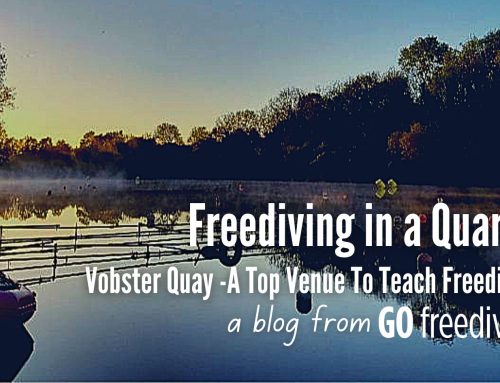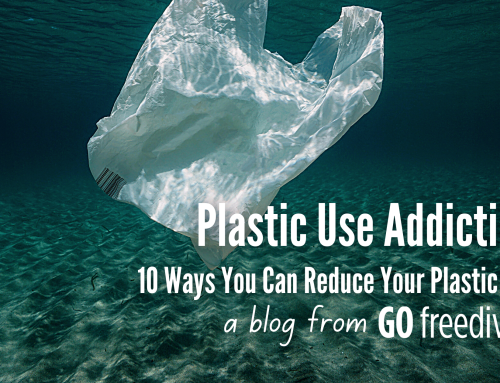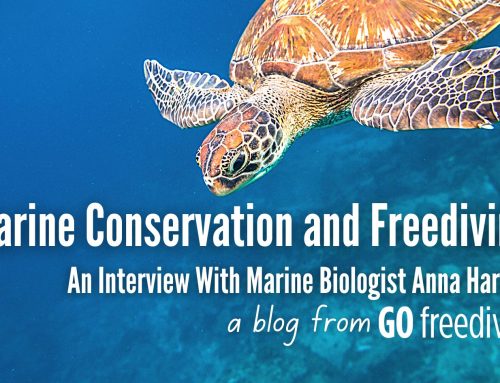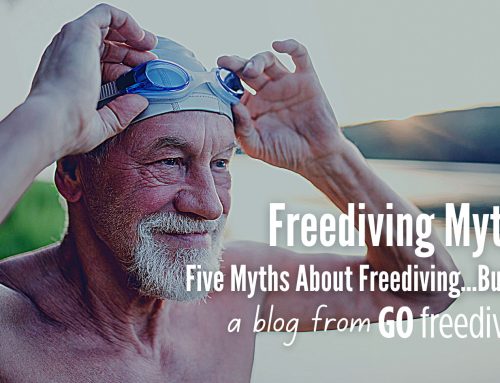Go Freediving instructors Emma and Pash found and rescued Harry the Hawksbill Turtle when freediving in the Maldives, but that was only the start of his journey to Dr Minnie at the Olive Ridley Project.
After successfully getting Harry out of the water, into a custom-made crate and onto a boat (his crate was too large for him to be transported via air) Emma and Pash thought the hardest part of the rescue was over.
However, not only could Harry not be taken by air – the quickest method – as his crate was too big, the boat that was transporting him to the atoll where the Olive Ridley Project was located was delayed due to rough seas.
Once the boat was able to launch, it broke down and had to be towed to another resort. Luckily, Minnie was able to arrange with her manager to use a speedboat to cross over to the resort and collect Harry urgently.
By now, everyone was getting very worried as Harry had been out of the water a very long time.
Then, Emma and Pash received the most wonderful news. Harry had arrived safety at the Olive Ridley Project and was with Dr Minnie.
Update from Minnie: Harry arrived after a forty hour trip on our supply boat, plus a few stops because of the bad weather. He was surprisingly okay when he arrived. He hadn’t really moved much from when he had started, but we put him straight in a tank and he did swim around – he was happy to be in water. We gave him fluids straight away and tried to feed him but he wasn’t really interested, so we gave him fluids and sugar supplements to improve his blood glucose, and we let him rest. When turtles usually arrive we give them a moment to rest before we start doing anything major.
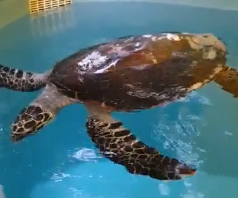
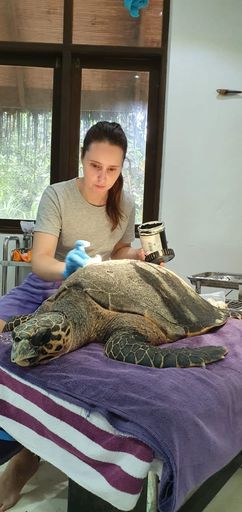
Following the successful rescue and delivery of Harry to Minnie the vet at the Olive Ridley Project both Pash and Emma kept in regular contact with Minnie regarding Harry’s health, even after they returned to the UK.
At weigh-in Harry was a very respectable 26.8kg so he was going to be a challenge.
The first obstacle Minnie faced was convincing Harry to convert to a fish diet!
Hawksbill Turtles feast mainly on sponges, which is not something the Olive Ridley Project could provide him at that time (but as Minnie said – she would if she could!)
Next, they needed to clean his shell so they could perform X-rays. Plus, the more clean his shell was the less likely there would be any other issues that could put him on the back foot.
He needed several burrowing barnacles removed, and a few crabs that had also taken up residence on his shell. But Harry was a total trooper and was soon back in the tank swimming around
Once he was all cleaned up, and before he went for his X rays Minnie performed an ultrasound to check for any potential foreign bodies in his gastrointestinal tract. This proved pretty challenging as Harry is quite large, but nothing untoward was found.
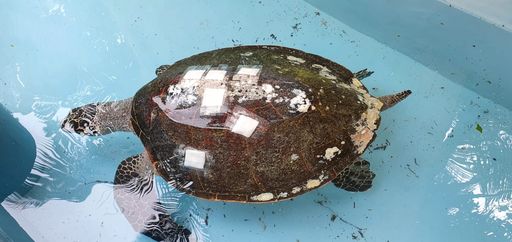
Harry back in the tank after having the burrowing barnacles removed
Harry was also put on a course of antibiotics as many turtles found in Harry’s state are immunocompromised. He was also given a fresh water bath to kill off some external parasites in readiness for X ray and blood sample day!
Minnie also determined that Harry was super dehydrated so gave him plenty of fluids and some multi-vitamins to help him with energy, while trying to figure out why he was having so many problems with buoyancy (his tail end kept floating up, making it hard for him to lift his front end up for breathing).

Harry having his ultrasound
Update from Minnie: Harry had a full diagnostic panel. I took a blood sample, I did x rays, full body x rays, which for him, because of the size of him was about fifteen x rays we took. We also did an ultrasound, and then I was waiting for him to pass motions so I could get a faecal sample. We did start him on antibiotics straight away, because I looked at his blood sample and he had quite a high white cell count, so he was showing signs of an infectious or inflammatory response. So then we went to a monitoring phase, so we could see what signs he was showing the first place.
His x rays showed he had quite a substantial gas distention of a lot of his intestines, so I spent a few days monitoring that by taking serial x rays, giving him gut movers, monitoring his faeces, trying to feed him, which he was not interested in. We ended up doing something called a Barium study, so I put a tube down his mouth, through his oesophagus into his stomach, and inserted a contrast medium which shows up on x ray. And that showed up really bright white, and I could watch that going through him, to try and identify if he had a blockage or not, and that took two or three weeks to actually show anything. It didn’t look like he had a blockage, but it was very hard to say, because he was so lethargic. He had the signs of a blockage, without having much on his x ray, so it was difficult to determine. In a very debilitated turtle, it can take a month to six weeks for gut transit, so it wasn’t completely abnormal, but it didn’t really help me decide that much if he had an obstruction or not, as it moved so slow, it was hard to determine if it was stuck anywhere, or it was just moving slowly.
After a month of treatment and waiting, Minnie decided to perform surgery to assess if he had a blockage or not. This involved pulling all of his intestines out and visually and manually assessing and examining them for any plastics, foreign bodies etc. The good news was that there was no obstruction or obvious sign of disease.
Once Minnie knew there was no obstruction she was able to insert a feeding tube to take over his nutrition.
Update from Minnie: Harry had the feeding tube inserted on the 21st of January 2021, and it wasn’t for about six weeks of two-four times a day feeding, plus other meds that we used to move his guts along, and pain relief, and antibiotics.
It wasn’t until about six weeks after the tube was inserted that he started showing any signs of normalcy. He started trying to dive, but then he’d spend a week doing not very much – things are very slow with sea turtles, and then eventually, closer towards March, he started trying to dive and staying down, and then he started resting on the bottom. But it took pretty much six to seven weeks of having the tube in, feeding him every single day, for him to actually show any signs of improvement..
It was very slow process, but the nutrition and the supplemental care, seemed to be all that he needed to ultimately get better.
This was great news! After his treatment and rehabilitation, Harry was starting to dive normally and become responsive to touch. He had no obvious signs of disease and no obstructions. However, the one thing Minnie still couldn’t get him to do, was eat.
As an adult male Hawksbill turtle, Harry has a very specific diet which is pretty much only sponges on reefs, in cracks and crevices. Minnie did manage to get him sponges from the reef, but he wouldn’t eat then because they weren’t in a normal situation.
He showed some interest in Sargassum, which is seaweed, but even though he was showing interest in food, he wouldn’t specifically eat.
Because he was about ninety-five percent of the way there, with the rest of his signs, Minnie decided it better to release him sooner so he could get back to a reef, and start showing normal behaviour, and eating normally, and understanding what he was looking for rather than being in a tank where he didn’t know what he was looking for.
And so, Harry was released!
A final note from Minnie: I love Harry. Not only was he a very interesting animal to have in, because he’s a Hawksbill, which is a bit different from what we normally get, but he’s an adult male, so he had spent his whole life doing his thing. He’s probably about twenty-five, thirty years old, it’s hard to say for sure, but he’s obviously spent a long life doing whatever he wanted, before he became sick. So it was a massive privilege to be able to look after him. He was also incredibly frustrating, and concerning, because at every single point I thought he might not make it, and he spent four months with me, and I was absolutely determined that if any turtle was going to make it, it was going to be Harry. So I put absolutely everything into him in all the diagnostic capacity that I had, all of the supportive care I had, and still I didn’t think he was going to do it, but he did it, and being able to actually put him back in the sea, and be confident that he will make it, even though we hadn’t seen a few things that we wanted to see from him, like eating, But knowing what he’s like, and knowing that he has actually probably been seen since, and he was eating, and he just looked so good when he was released, that I am very confident that he is absolutely fine, and I’m so chuffed that I could get him back out there because he’s so important.
I get calls from all over the place, from all sorts of people. My phone’s on 24/7 and I’m always ready for these sort of things. So, when I heard Emma on the other end of the phone, it was very cool to hear another person from the same country I’m from, and to be able to reassure her that I could look after him, because obviously Emma and Pash were a bit desperate to find somewhere for him to go, because the resort didn’t know where he could be, so I was able to say ‘yeah, of course I can take him, it’s fine’, so I’m sure that was quite a relief.
It was really nice to talk to Emma and say ‘okay, I need this and need this and need this, so maybe you can push the resort to do this, I’ll send you this by email, I’ll send you this by text, send me some pictures, and I’ll arrange his transport.’ It was so nice to hear that someone was so dedicated. You guys were one hundred percent going to get him to me, and so I could one hundred percent rely on you straight away, to know that you’d get it sorted, you’d get this done, you’ll get that done, and I can get him here.
I absolutely adore that turtle, I love that turtle. He’s taught me a lot, he’s very interesting. I’m quite new to sea turtle veterinary medicine in the first place, and I’m aware of my own relative inexperience, and compared to others, but he was a very interesting case, very medically challenging, very informative, and also very uplifting. So I was very lucky to be his vet, and to be able to get him back out there. There were a lot of first with Harry, my first feeding tube, my first exploratory laparotomy, so my first invasive surgery. My first barium study, so a lot of what i did with him was the first time I’d done it, but I was confident it would work, so it was a lot of new experiences, but he was the best and I love him.
I will never forget Harry, he’s one hundred percent my number one turtle. I said to everyone I was dealing with, all the other vets and everyone online, that if I can get Harry through it, it will be my greatest professional achievement as a sea turtle vet is to get him back out to the sea. Because in that time frame, I had quite a few turtles that didn’t make it. Turtles came and went multiple times when he was there.
Harry was with us for four months, and I’ve seen six turtles die in that time frame, from other bad illnesses they came in with, so he was a constant. I kept him going when I couldn’t keep others going, so it was very rewarding. He is so important, because the conservative estimate in that one in one thousand hatchlings make it to adulthood, so being a very established male as he was, he’d already beaten so many odds to get to that point, and be fully grown. He’d almost certainly already bred, and he’s a critically endangered species, so they are just one step above extinction, so in a conservation sense, he’s much more important than younger turtles, because he’s proven himself, so from a conservation standpoint, and a species standpoint, he was the most important turtle that we had.
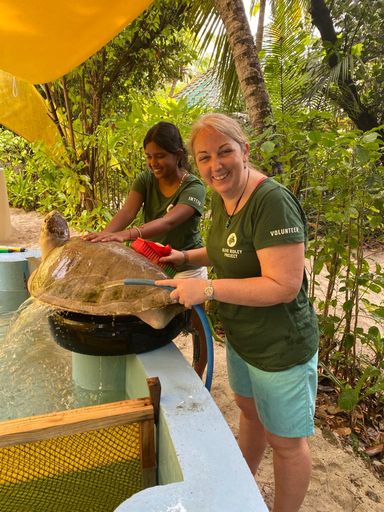
Although this was where we all said a very happy goodbye to Harry, this is not the end of the story.
We were so impressed with Minnie’s dedication and the work of the Olive Ridley Project, that Pash found the time to return to the Madlives for a two week volunteering project. It was a chance not only for her to meet Minne and thank her for everything she had done for Harry, but also for her to show our appreciation by teaching Minne to freedive!
Follow Pash’s journey at the Olive Ridley Project in our next blog!
If you would like to donate to the Olive Ridley Project, you can do so HERE
Want to learn to freedive with the best? Learn to freedive with Go Freediving!
Go Freediving is the longest established, most experienced and friendliest freediving course provider in the UK, led by world class freediving instructor trainer Emma Farrell, and her team of personally trained instructors. No other course provider has such a good instructor to student ratio, safety record and personal touch.
Whether you’re a beginner dipping your toes into the world of freediving, a seasoned pro looking to turn professional, or simply a freediver of any level who wants the best freediving holiday in the world, we’re here for you!
Also check out our online guide, The Beginners Guide to Freediving by clicking here!
Keep in touch with everything Freediving
Subscribe to our mailing list for weekly newsletters with exclusive articles, news, films, offers and more!
And check out You Tube!
